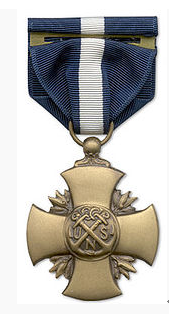
| Navy Cross | |
 |
|
| Awarded by United States Department of the Navy | |
| Type | Medal (Decoration) |
| Awarded for | distinguishes himself or herself in action by extraordinary heroism in combat not justifying the Medal of Honor. |
| Status | Currently awarded |
| Statistics | |
| First awarded | 1917 |
| Precedence | |
| Next (higher) | Medal of Honor |
| Equivalent |
Army: Distinguished Service Cross Marine Corps: Navy Cross Air Force: Air Force Cross Coast Guard: Coast Guard Cross |
| Next (lower) | Distinguished Service Medals:Defense, Homeland Security, Army, Navy (Navy-Marine), Air Force, Coast Guard |
The Navy Cross is the second highest military decoration for valor that may be awarded to a member of the United States Navy, Marine Corps, or Coast Guard (when operating under the Department of the Navy) for extraordinary heroism in combat.It is equivalent to the Army's Distinguished Service Cross, the Air Force's Air Force Cross and the Coast Guard's Coast Guard Cross.
The Navy Cross is bestowed by the Secretary of the Navy and may also be awarded to members of the other armed services, and to foreign military personnel while serving with the U.S. naval services. The Navy Cross was established by Act of Congress (Public Law 65-253) and approved on February 4, 1919.
History
The Navy Cross was instituted in part due to the entrance of the United States into World War I. Many European nations had the custom of decorating heroes from other nations, but the Medal of Honor was the sole American award for valor at the time.The Army instituted the Distinguished Service Cross andDistinguished Service Medal in 1918, while the Navy followed suit in 1919, retroactive to 6 April 1917. Originally, the Navy Cross was lower in precedence than the Navy Distinguished Service Medal, because it was awarded for both combat heroism and for "other distinguished service."Congress revised this on 7 August 1942, making the Navy Cross a combat-only award and second only to the Medal of Honor. Since its creation, it has been awarded more than 6,300 times.It was designed by James Earle Fraser.
The first actual recipient of the Navy Cross is unknown because initial awards were made from a lengthy list published after World War I.
Criteria
Crew members: Jonell Copeland, AtM2/c; Que Gant, StM; Harold Clark, Jr., StM; James Eddie Dockery, StM; Alonzo Alexander Swann, StM; and Eli Benjamin, StM were given the Navy Cross for standing by their gun when their ship was damaged by enemy attack in the Philippine area, ca. 1945
The Navy Cross may be awarded to any member of the U.S. Armed Forces while serving with the Navy, Marine Corps, or Coast Guard (in time of war only) who distinguishes himself or herself in action by extraordinary heroism not justifying an award of the Medal of Honor. The action must take place under one of three circumstances:
While engaged in action against an enemy of the United States
While engaged in military operations involving conflict with an opposing foreign force
While serving with friendly foreign forces engaged in an armed conflict in which the United States is not a belligerent party.
The act(s) to be commended must be performed in the presence of great danger or at great personal risk and must be performed in such a manner as to render the individual highly conspicuous among others of equal grade, rate, experience, or position of responsibility. An accumulation of minor acts of heroism does not justify an award of the Navy Cross.
As originally authorized, the Navy Cross could be awarded for distinguished non-combat acts, but legislation of 7 August 1942 limited the award to acts of combat heroism.
Wear
Originally the Navy Cross was the Navy's third-highest decoration, after the Medal of Honor and the Navy Distinguished Service Medal. On 7 August 1942, Congress revised the precedence, making the Navy Cross senior to the Distinguished Service Medal. Since that time the Navy Cross has been worn after the Medal of Honor and before all other decorations.
Additional awards of the Navy Cross are denoted by gold and silver 5/16 inch stars affixed to the suspension and service ribbon of the medal; a silver star would indicate a sixth award.
Description and symbolism
The award has been found similar in appearance to the British Distinguished Service Cross.The earliest awards (1919–1928) featured a more narrow strip of white, while the so-called "Black Widow" medals awarded from 1941–1942 were notable for the dark color due to over-anodized finish.
Obverse
The Navy Cross is a modified cross pattée one and a half inches wide. The ends of its arms are rounded whereas a conventional cross patée has arms that are straight on the end. There are four laurel leaves with berries in each of the re-entrant arms of the cross. In the center of the cross a sailing vessel is depicted on waves, sailing to the viewer's left. The vessel is a symbolic caravel of the type used between 1480 and 1500. Fraser selected the caravel because it was a symbol often used by the Naval Academy and because it represented both naval service and the tradition of the sea. The laurel leaves with berries refer to achievement.
Reverse
In the center of a bronze cross pattée, one and a half inches wide, are crossed anchors from the pre-1850 period, with cables attached. The letters USN are evident amid the anchors.
Ribbon
The service ribbon is navy blue with a center stripe of white identical to the suspension ribbon of the medal. The blue alludes to naval service; the white represents the purity of selflessness.



















